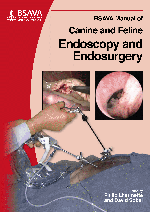
Full text loading...

PLEASE NOTE THAT A MORE RECENT EDITION OF THIS TITLE IS AVAILABLE IN THE LIBRARY
The use of rigid endoscopy for joint surgery has been the standard in human and equine orthopaedics for over three decades. The use of arthroscopy in small animals for the treatment and diagnosis of joint diseases has increased dramatically in the last 10-15 years due to advances in equipment and techniques. Numerous benefits of arthroscopy have been cited, including improved viewing and magnification of lesions, decreased operative time, minimal joint trauma, and lower patient morbidity. There is, however, a considerable learning curve, and these advantages can only be achieved through practice and an understanding and correct selection of arthroscopic equipment. This chapter provides am introduction to small animal arthroscopy through its indications, ancillary procedures, instrumentation and current applications.
Rigid endoscopy: arthroscopy, Page 1 of 1
< Previous page | Next page > /docserver/preview/fulltext/10.22233/9781905319572/9781905319572.13-1.gif

Full text loading...






























































